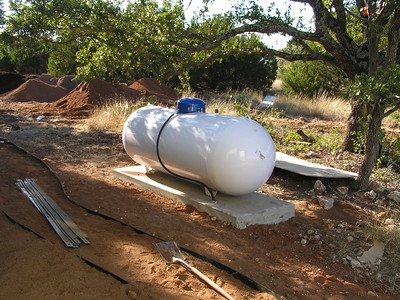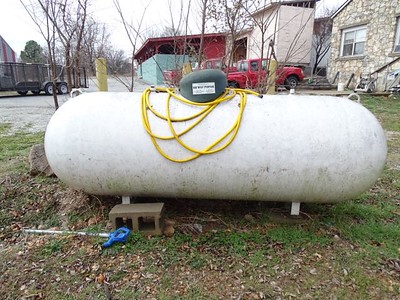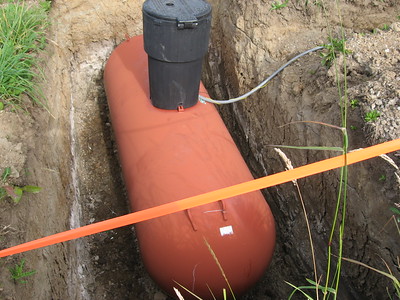Choosing the right propane tank size can feel a bit overwhelming, especially if you’re not sure how much propane you’ll need. In this article, we’ll break it down for you in simple terms.
We’ll help you understand the differences between a 250-gallon tank and a 500-gallon tank, so you can decide which one is the best fit for your home and lifestyle.
Whether you’re heating your home, cooking, or using propane for other things, we’ll guide you through the pros and cons of each tank size. By the end, you’ll have a clearer idea of which tank is right for you.
The 250-Gallon Propane Tank
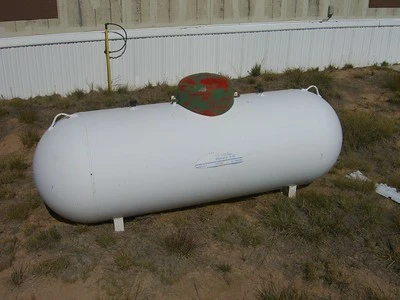
What It Offers:
- Capacity: A 250-gallon tank can hold approximately 200 gallons of propane when filled to the standard 80% capacity. The remaining 20% is left empty to allow for gas expansion.
- Usage Duration: For a household that uses around 100 gallons of propane per month, this tank could last about 2 months before needing a refill. If you use propane for heating during winter, you might need to refill every 6 to 8 weeks.
- Appliance Usage: If you use propane for a stove, water heater, and some home heating, this tank can support your needs for a moderate period. For example, a typical stove uses around 5 to 10 gallons per month, while a water heater might use 10 to 20 gallons per month.
Best for Small to Medium Homes:
- Smaller Homes (1,000 to 1,500 square feet): In homes of this size, with average insulation, a 250-gallon tank can handle heating needs for mild winters or homes that use propane for cooking and water heating without frequent refills.
- Moderate Usage: If your propane needs are limited to basic home functions—such as a stove, water heater, or fireplace—a 250-gallon tank will likely be sufficient. For example, using propane for just cooking and water heating could use around 20 to 30 gallons per month, giving you several months of use before needing a refill.
- Backup Power: For homes that use propane as a backup power source, this tank can power a generator for up to a week during power outages, depending on the size of your generator and how much you use it.
Pros and Cons:
- Pros:
- Compact Size: A 250-gallon tank is about 7.5 feet long and 30 inches in diameter, making it easier to install in smaller yards or tight spaces.
- Lower Initial Cost: The upfront cost of purchasing and installing a 250-gallon tank is generally lower than that of a larger tank. Installation costs might range from $1,000 to $2,000, depending on your location.
- Flexible Usage: This tank is versatile for homes with moderate propane needs or as a supplemental energy source.
- Cons:
- More Frequent Refills: Because of its smaller size, you’ll likely need to schedule propane deliveries more often. For example, if you use around 80 gallons per month for heating and cooking, you’ll need to refill the tank every 2 to 3 months during winter.
- Higher Cost Per Gallon: Smaller deliveries can sometimes cost more per gallon compared to larger deliveries, which could slightly increase your overall propane expenses. For example, you might pay 10 to 20 cents more per gallon on smaller deliveries.
These detailed explanations should give readers a clearer picture of what a 250-gallon propane tank offers, making it easier for them to decide if it’s the right size for their needs.
The 500-Gallon Propane Tank
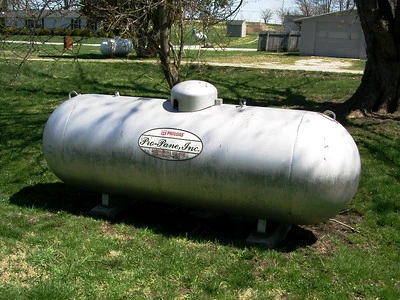
What It Offers:
- Capacity: A 500-gallon propane tank can hold about 400 gallons of propane when filled to the standard 80% capacity. This is double the capacity of a 250-gallon tank, allowing you to store more propane at once.
- Reduced Refill Frequency: With this larger capacity, a 500-gallon tank significantly reduces the need for frequent refills. For example, if your home uses around 100 gallons of propane per month, this tank could last approximately 4 months before needing a refill. This is especially beneficial during the winter months when propane usage tends to be higher.
- Supports Multiple Appliances: A 500-gallon tank can easily support multiple propane-powered appliances, including your furnace, water heater, stove, and more, without running out of fuel quickly.
Best for Larger Homes or High Usage:
- Larger Homes (1,500 to 2,500 square feet or more): In larger homes with higher heating demands, a 500-gallon tank provides enough propane to keep everything running smoothly without constant worry about refills. For example, heating a home of this size might use 100 to 150 gallons of propane per month during the colder months.
- High Usage Households: If your household relies heavily on propane for heating, cooking, water heating, and possibly even a pool heater, this tank size is ideal. A larger family with multiple appliances running on propane might use 150 to 200 gallons per month, making the 500-gallon tank a more practical option.
- Backup Power for Extended Periods: For homes using propane as a backup power source, a 500-gallon tank can run a generator for several weeks during extended power outages, depending on usage.
Pros and Cons:
- Pros:
- Longer Refill Intervals: One of the biggest advantages of a 500-gallon tank is that it reduces the frequency of refills. For instance, if you use 100 gallons of propane per month, you might only need to refill the tank 2 to 3 times a year, providing peace of mind during peak usage times.
- Cost Savings on Refills: Because you’re buying propane in larger quantities, you may get a better price per gallon compared to smaller tanks. This can lead to savings over time, especially if you fill the tank during off-peak seasons when propane prices are lower.
- More Energy Independence: Having a larger propane reserve means you’re less dependent on frequent deliveries, which can be especially beneficial in rural areas or during times of high demand.
- Cons:
- More Space Required: A 500-gallon tank is larger, typically around 10 feet long and 38 inches in diameter. You’ll need sufficient space on your property to install it, which might be a challenge for smaller yards.
- Higher Initial Cost: The cost of purchasing and installing a 500-gallon tank is higher than that of smaller tanks. Installation might range from $1,500 to $3,000 or more, depending on your location and any additional work required, like burying the tank.
- Overkill for Small Homes: If your propane needs are low, this tank might be more than you need, leading to propane sitting unused for long periods, which isn’t ideal for maintaining fuel quality.
This explanation should help readers understand the benefits and considerations of choosing a 500-gallon propane tank, allowing them to make an informed decision based on their household size and energy needs.
Factors to Consider When Choosing
1. Space Availability:
- Tank Size: A 250-gallon tank is about 7.5 feet long and 30 inches in diameter. In contrast, a 500-gallon tank is larger, measuring around 10 feet long and 38 inches in diameter. Before choosing a tank size, it’s important to measure the available space in your yard. Make sure there’s enough room for the tank itself and any required clearances. Local regulations might require that propane tanks be installed a certain distance from your home, fences, or other structures. For example, some areas require at least 10 feet of clearance from buildings or property lines for safety reasons.
- Installation Options: If space is limited, the smaller 250-gallon tank might be easier to accommodate. However, if you have a larger yard or don’t mind dedicating more space to a propane tank, the 500-gallon tank can save you from frequent refills. In addition, if you have the option to bury the tank, make sure you have the necessary space for excavation and proper installation, which might be more challenging with the larger tank.
2. Initial Costs:
- 250-Gallon Tank: The cost of purchasing and installing a 250-gallon tank generally ranges from $1,000 to $2,000. This price typically includes the tank itself, the labor for installation, and any necessary permits. However, the cost can vary based on your location, whether you’re installing the tank above or below ground, and any additional equipment required, like a concrete pad or safety barriers.
- 500-Gallon Tank: A 500-gallon tank comes with a higher price tag, usually between $1,500 and $3,000 or more. This reflects the larger size of the tank and the increased complexity of installation. If you’re planning to bury the tank, the cost could go even higher due to the need for excavation, additional safety measures, and possibly a protective coating for the tank.
- Budget Consideration: If you’re trying to keep initial expenses low, the 250-gallon tank might be a more budget-friendly option. However, consider that a larger tank could save you money in the long run by reducing the number of propane deliveries, which might offer a lower price per gallon when you fill the tank. Over time, the savings from fewer refills could offset the higher upfront cost of the 500-gallon tank.
3. Refill Frequency:
- 250-Gallon Tank: A 250-gallon tank holds around 200 gallons of propane when filled to the safety standard of 80%. If your home uses 80 to 100 gallons of propane per month, you’ll need to refill the tank every 2 to 3 months. This means you’ll need to schedule more frequent deliveries, which can be inconvenient, especially during the winter months when demand for propane is high and deliveries may be delayed. Additionally, smaller deliveries often come with a higher cost per gallon, so more frequent refills might add to your overall propane expenses.
- 500-Gallon Tank: A 500-gallon tank holds around 400 gallons of propane at 80% capacity. With the same usage of 80 to 100 gallons per month, this tank can last 4 to 6 months before needing a refill. This longer interval between refills can provide peace of mind, particularly during the colder months when you’re using more propane for heating. Fewer refills also mean fewer delivery fees and, potentially, a lower price per gallon, as propane companies often offer discounts for larger fills. This can lead to cost savings over time and greater convenience for you.
4. Future Needs:
- Household Changes: When choosing a propane tank, think about your future plans. If you’re planning to expand your home or add propane-powered appliances like a fireplace, pool heater, or generator, your propane usage could increase significantly. A 500-gallon tank might be a better choice if you anticipate higher propane demand in the future, as it can store more fuel and reduce the frequency of refills. For example, adding a propane fireplace could increase your usage by 50 to 100 gallons per season, while a pool heater could use 4 gallons per hour.
- Long-Term Consideration: Consider your long-term energy needs. If you expect your household to grow or if you’re planning to transition more of your energy usage to propane, opting for a larger tank now could save you the hassle of upgrading later. For example, if you’re considering adding a propane generator for backup power, a 500-gallon tank would give you more flexibility to run the generator for extended periods during power outages without worrying about running out of fuel.
By carefully considering these factors, readers can make a more informed decision on whether a 250-gallon or 500-gallon propane tank is the right choice for their current and future needs.
Making the Final Decision
1. Balancing Convenience and Cost:
- Convenience: A larger tank, like the 500-gallon option, offers the convenience of fewer refills, which can be especially helpful during colder months or if you have a busy schedule. With a 500-gallon tank, you may only need to refill 2 to 3 times a year, providing peace of mind and reducing the hassle of frequent deliveries. This is ideal for those who prioritize convenience and want to avoid running out of propane during peak usage times.
- Cost: However, the convenience of a larger tank comes with higher upfront costs. The 500-gallon tank is more expensive to purchase and install, and it requires more space. If your budget is tight or you have limited space, the 250-gallon tank might be a more practical choice, even though it requires more frequent refills. Over time, the cost difference might balance out, as a larger tank could save you money on propane by allowing you to buy in bulk and take advantage of lower per-gallon prices during off-peak times.
- Space Requirements: Consider the physical space you have available for the tank. If your yard or property has ample space, the larger tank might be a better option. However, if space is limited, the 250-gallon tank could be a better fit, even if it means more frequent refills.
Summary: Balancing convenience and cost involves weighing the benefits of fewer refills and potential long-term savings with the higher initial cost and space needs of a larger tank. If convenience and long-term cost savings are your priority, and you have the space, the 500-gallon tank is likely the better choice. However, if upfront costs and space are more pressing concerns, the 250-gallon tank may be the more practical option.
2. Recommendations Based on Lifestyle:
- Small Homes or Seasonal Use: If you live in a small home (under 1,500 square feet) or only use propane seasonally—such as for a vacation home or occasional heating—a 250-gallon tank should be sufficient. This is also a good choice if you only use propane for specific appliances like a stove or water heater. The smaller tank provides enough capacity without taking up too much space, and the initial cost is more manageable.
- Moderate to High Usage: If your home is larger (1,500 to 2,500 square feet) and you use propane regularly for heating, cooking, and other appliances, a 500-gallon tank is likely the better option. It will reduce the number of refills you need throughout the year and offer more flexibility for increased usage, such as during winter months or if you add more propane-powered appliances in the future.
- Families or Growing Households: For larger families or those who anticipate growing energy needs, the 500-gallon tank provides the capacity to handle higher usage. This is especially true if you have multiple propane appliances or use propane as a primary energy source. The larger tank minimizes the risk of running out of propane and allows for greater energy independence.
- Rural or Off-Grid Homes: If you live in a rural area or are off the grid, a 500-gallon tank offers the added security of a larger fuel reserve, reducing your dependency on frequent deliveries. This is particularly important if you rely on propane for heating, cooking, and backup power, as it ensures you have enough fuel to last through extended periods without deliveries.
By considering your lifestyle, home size, and propane usage, these recommendations can help you choose the right propane tank size that fits your needs, budget, and long-term plans.
To Conclude This
Deciding between a 250-gallon and a 500-gallon propane tank ultimately comes down to your specific needs, budget, and available space.
If you live in a smaller home or only use propane for a few appliances, the 250-gallon tank might be all you need. It’s more affordable upfront and takes up less space, though you’ll need to schedule more frequent refills.
On the other hand, if you have a larger home, higher propane usage, or simply prefer the convenience of fewer refills, the 500-gallon tank is likely the better choice. While it comes with a higher initial cost and requires more space, it can save you money in the long run and provide greater peace of mind, especially during peak usage seasons.
In the end, assess your current and future propane needs, consider your budget, and weigh the pros and cons of each option. By doing so, you’ll be able to choose the propane tank size that best suits your home and lifestyle.
Image sources: frammisface (Flickr)

Mike is an experienced propane technician with over 15 years of professional experience in the field. He has dedicated his career to helping customers with their propane needs, from installation to maintenance and repair. Together with Jeremy, he co-founded this website to provide useful information and guidance to customers seeking reliable propane services.
